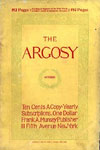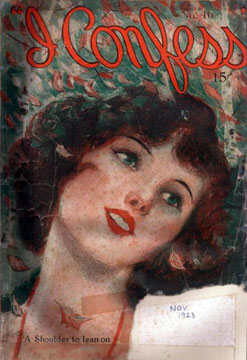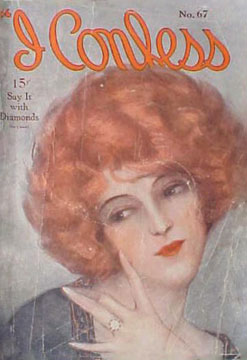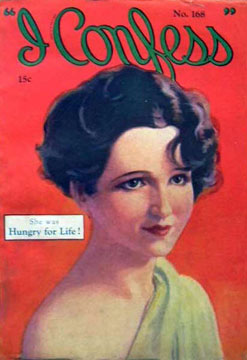"I Confess"
The covers appealed to women in particular with the promise to deliver true-to-life experience and life-lessons. The price—ten cents a copy—increased that appeal by beating out other "true" magazines, which sold for double the price. The cover models were beautiful, fashionable, young, and white. The magazine was "I Confess". It ran from February 1922 to February 1932.
George T. Delacorte was "the man who understood what the general public wanted." Graduating from the University of Columbia, he began his career in the magazine business by handing out cigars for New Fiction Publishing Co., publisher of Snappy Stories and Live Stories, to NYC newsstand owners. Delacorte eventually became president of the company, and after resigning his position as general manager in 1922, he started his own company, Dell Publishing, by launching "I Confess" in February of that year (Printer's Ink 189). This was Delacorte's pulpwood version of Bernarr Macfadden's True Story (See Note 1). The magazine ran as a bi-weekly, appearing "on every news stand on every other Friday" ("I Confess").
"I Confess" was first offered for only ten cents a copy. From the magazine's start, however, readers' letters to the editor continued to request “wonderful pictures...more stories...[and] more departments and features" ("I Confess" 4). In the eighteenth issue (dated Oct. 6, 1922), Delacorte responded with an announcement of a brand new "I CONFESS in gala attire." In this letter from the editor, Delacorte informed his readers that "I Confess" would not only increase from 64 pages to 80 pages, but also include precisely what the readers requested: more stories, beautiful covers, dozens of illustrations, and additional departments. Delacorte's letter also announced the price increase from 10 cents to 15 cents per copy, which was necessary to compensate for these changes. The cover price for "I Confess" was dropped back down to 10 cents per copy in 1931.
Elizabeth Sharp, editor of "I Confess", strongly dictated the personality and contents of each issue of the magazine. In August 1922, The Editor claimed that "[Sharp] does not want 'confessions' in which the plot is lacking in episode, and drama and character too unsympathetic.... [H]er readers desire plenty of action...." (Fillery 74). In the March 1922 issue of The Writer—a monthly trade magazine for literary workers—an advertisement solicits story submissions for "I Confess" with the following appeal:
A magazine of personal experiences using short stories of from [sic] 3,500 words to 5,000 words, and serials from 20,000 words to 30,000 words, printing about 5,000 words per part. Stories should read as if they were personal experiences [and] be told in words of one or two syllables. (2)
Another advertisement for the magazine reads:
"I Confess" (NY), a new bi-weekly magazine, esp. needs short stories, of about 3,500 words, told in the first person. Characters, incidents, and settings should be such as have come within the range of the writer’s actual experience. (40)
This ad suggests further that stories should have a "love-motive," but must be toned town if sex is the central theme. Sharp maintained a clean, yet gripping content for the magazine, and the stories are exactly that—morally clean, yet emotionally gripping. Many involve a strongly sympathetic (but ordinary) female character caught up in some self-imposed hardship, and they typically end happily with love and marriage.
The cover story of the October 1922 issue, titled "Dancing into Danger: A Chorus Girl’s Love Story," features a seventeen-year-old girl from New York, who lies about her age in order to marry a man and run away with him to Paris. Before long, she finds herself not knowing whether to commit to the marriage and stay with the husband—whom she may not love—or return to the stage. In "The Queen of Wheats," the cover story for the January 1923 issue, a restaurant waitress falls in love with a farm boy, who is disguised as a city gentlemen. The girl also pretends to be from a wealthy family. The two eventually reveal their true backgrounds, and accept each other regardless of money or social class. Both stories feature ordinary working girls, ultimately motivated by love.
Others seem to have been copied directly from an adolescent girl's diary, the same girls the Saturday Evening Post labelled "MacFadden’s anonymous amateur illiterates" (MacFadden 224), while others reveal a strong political voice. "Hearts That I Harnessed" from October 1922, for example, contains the following passage:
This may seem all wrong, but my observation has been that virtue that is not based on a sound foundation of sense and utilitarianism is an artificial and pretty frail sort of thing. Things are much more sane and peaceable in those countries where a woman's virtue is given a real value, as something useful to the social body—or useless, as the case may be. (55-59)
Contributions were also at times submitted in response to other stories. One, "The Mother-in-law Hits Back," declares:
Here's a reply to 'Why I hate Mother-in-laws.' Published some time ago on the hard lot of a son-in-law—there are two sides to this question. (13)
This type of "read and respond" story helped to create a sense of community among readers of the magazine.
Delacorte numbered his magazines instead of dating them. He claimed that to avoid the risk of unsold copies, he first put them on sale east of the Rocky Mountains and south of Canada. If an issue did not sell, he just trimmed the edges of the unsold copies and attempted to re-sell them, this time west of the Rocky Mountains and in Canada (Peterson 271).
Early issues of the magazine were marketed as featuring completely factual stories; and their covers even stated "every word true." By issue twenty-five, however, this phrase was removed from covers. Instead the magazine began to advertise its stories as having the "throb of real life." In his book Trial and Error, Jack Woodford describes the fictional nature of these so-called true experiences written for "I Confess":
A writer friend of mine...dropped in to see the lady editor of I Confess Magazine.... They got along together splendidly from the start, and were chatting enjoyable when an office girl entered to announce that a certain writer (male) who specializes in confession stories had arrived for a consultation with the editor. The editor of I Confess Magazine...exclaimed in annoyance and petulance at thus being disturbed: "Christ! There's that darned unwed mother come to see me again. I'm sorry. We'll have to cut our chat short." (Woodford 126-127)
This story is second hand, and it may not be completely accurate; but it does reinforce a generally accepted notion that, in practice, most readers' attitudes toward authorship in the confession magazines were skeptical, as a rule. The readers of "true experiences" were aware that authors used pseudonyms, as authors themselves were not adverse to admit it. Woodford describes having “written confession stories for...I Confess Magazine, and several other confession story magazines” (126). In these anonymous forums for so-called true stories that were not necessarily true, the gendered voices might well be performative as par for the course, not only to disguise the authors' identities, but also to participate in the kind of virtual world these magazines offered.
A section titled "The Trouble Doctor's Department" invited readers to write to the "Trouble Doctor" about their personal problems, with responses to be published in later issues through the same department. Eleven out of fourteen letters published in the October 1922 issue are attributed to female readers; half of them from girls under the age of 18. The seven letters published in the January 1923 issue are all attributed to girls under the age of 19.
In 1926, the circulation of "I Confess" totalled 160,041 for the year. Just a year later, however, the magazine shows a sharp decrease in its annual sales, with circulation at 144,393 for the year. In 1928, it switched from a bi-weekly to a monthly schedule, almost always a sign that a magazine is faring poorly at the newsstands (Audit Bureau of Circulation).
The magazine ran for just 10 years, ceasing publication in February 1932. It was an exemplary model of the active participation of readers in the world of pulp magazines. With its letters to the editor, stories from readers, and prize-winning contests, "I Confess" was always a magazine for the reader and by the reader—a grand portrait of America’s mass literary audience.
Lauren Gibson, The University of West Florida
NOTE 1. Macfadden's first magazine, Physical Culture (1899), contained a write-in section called "Questions from Health-Seekers" (Marchand 53-4). His wife, Mary, enjoyed the true and first-hand confessions by women in letters to the editor, and presented the idea of an entire magazine devoted to true experiences written by the readers of the magazine. Upon hearing of the idea, one staff member exclaimed: "Everybody will want to read that one. All the working girls go through the same love troubles. This one will be about themselves and written by themselves" (Macfadden 29). It was a shockingly successful formula, and True Story had a circulation of nearly two million by 1926 (Sivulka 140).
Works Cited
Berger, Merilyn. "G.T. Delacorte, Philanthropist, 97, Dies." The New York Times (May 5, 1991).
Fillery, William E.; and Will H. Greenfield. "The Experience Exchange." The Editor 58 (1922). Library of Princeton University.
"Delacorte, G.T., Jr., Forms Dell Publishing Co." Printers' Ink 118 (May 1, 1922): 189.
Gerbner, George. "The Social Role of the Confession Magazine." Social Problems 6 (1958): 29.
"I Confess" (Oct. 1922 & Jan. 1923). NY: Dell Publishing Co.: en passim.
Macfadden, Bernarr; and E. Gauvreau. Dumbells and Carrot Strips. NY: Holt, 1953, pp. 218-19.





